
Part 3: Country Area Service
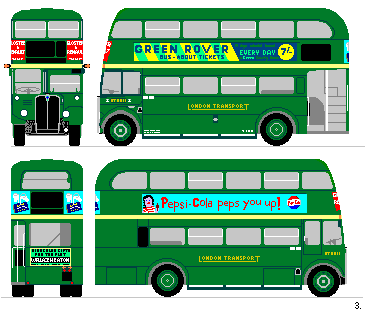 Often the Country Area had to wait until the Central Area had updated its fleet,
then receiving the hand-downs, but the RTs went to both Country and Central areas,
almost from the beginning.
Perhaps this was because the Country Area had a desperate need
to replace the hand-downs from before the war: STs, TDs and relics from the early thirties.
Often the Country Area had to wait until the Central Area had updated its fleet,
then receiving the hand-downs, but the RTs went to both Country and Central areas,
almost from the beginning.
Perhaps this was because the Country Area had a desperate need
to replace the hand-downs from before the war: STs, TDs and relics from the early thirties.
Once the worst horrors had gone there was the collection of STLs
that had drifted out from London both during and after the war,
and the Country STLs.
Up in the Watford Area there were the
postwar provincial STLs
which were distinctly non-standard, but very saleable. They were sold in 1955,
incidentally giving a new lease of service life to eight wartime RTs.
So by the mid-fifties the Country Area had a totally modern fleet,
with new RTs, new RF single-deckers,
new <../GS/gs.html">GSs for one-man operation and
new RLHs on lowbridge work.
Country Area RT
Below: Country Area RT: RT2083 at Brooklands runway, April 1998.
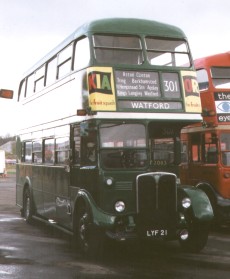
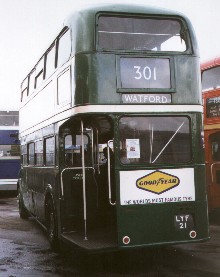 As in the Central Area, the Country Area found itself hit hard by the changes in leisure technology.
Car ownership escalated even faster in the properous periphery of London,
and the pre-war experience that Sunday was the busiest day of the week,
with every Country vehicle in service plus many borrowed
from the Central Area for the day changed rapidly
as folk in the inner cities began to experience the joys of weekend motoring.
Evening travel to and from the cinema also suffered from the advent of television.
As in the Central Area, the Country Area found itself hit hard by the changes in leisure technology.
Car ownership escalated even faster in the properous periphery of London,
and the pre-war experience that Sunday was the busiest day of the week,
with every Country vehicle in service plus many borrowed
from the Central Area for the day changed rapidly
as folk in the inner cities began to experience the joys of weekend motoring.
Evening travel to and from the cinema also suffered from the advent of television.
These trends could have been disastrous for the Country Area,
but for the growth of the new towns around London,
and the spread of suburbia into its area.
Consequently total ridership on Country services
actually grew slightly during the fifties,
although Sunday travel dropped very rapidly.
Nevertheless, there were 81 green RTs placed into store at the end of RT production
in 1954, to emerge five years later.
RT4773 was the last RT to enter service, at Northfleet in August 1959.
The GreenLine RTs
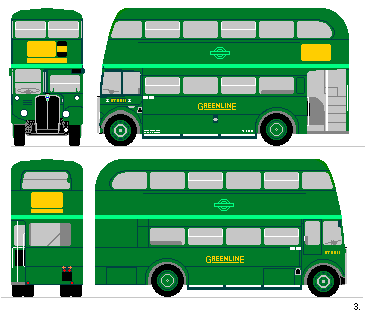 Thirty six of the new buses (RT3224-3259, by Weymann)
were painted green with a pale green band and labelled for Green Line.
As Green Line "coaches" they carried no adverts,
and had a small raised metal bullseye symbol
mounted on the side panels between the decks.
They were fitted with standard RT seats, but had heaters,
which at that date earned them a new type code: RT8/1.
Thirty six of the new buses (RT3224-3259, by Weymann)
were painted green with a pale green band and labelled for Green Line.
As Green Line "coaches" they carried no adverts,
and had a small raised metal bullseye symbol
mounted on the side panels between the decks.
They were fitted with standard RT seats, but had heaters,
which at that date earned them a new type code: RT8/1.
They went to work on that traditional double-decker Greenline route,
the 722 from Aldgate to Upminster, operated from Romford (RE).
There they replaced the Greenline Daimler austerities, and as such were a welcome relief.
When the SRTs yielded up their bodies to new RT chassis
twenty-one of them (RT4489-RT4509) were also given Green Line livery,
with metal GreenLine bullseyes on the side advert panels.
These were used as reliefs for the hard-pressed and frequently overloaded Green Line services around the system,
replacing standard country RTs.
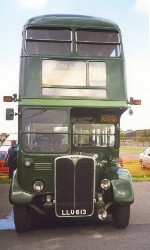
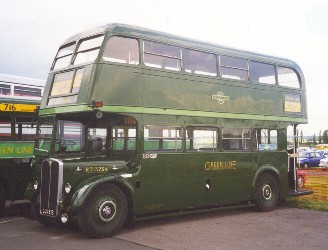
A further twenty -eight RTs joined them in 1960 for relief duties,
these having GreenLine livery and fleetnames, but a transfer bullseye rather than the posh metal one.
The advent of the
RMCs
in 1965 put paid to most of their relief work,
and the RCLs
replaced the class on the Romford services.
Suddenly they were redundant, and 62 of them were demoted to bus work and repainted accordingly.
The remaining 23 still found enough work to keep them special for a while, but three more were demoted in 1967
and the others followed in November 1969.
GreenLine RT: RT3254 of the original batch,
now in preservation, at North Weald, June 1998.
Photos by Ian Smith. Click for larger versions.
London Country Area in the 1960s
Just as the red RTs became part of the background in London,
so did the green RTs around the Home Counties.
They were worked hard, the outer suburbs,
New Towns and long radial and cross-country routes being no sinecure.
As with the Central buses,
the Country cousins enjoyed five-yearly overhauls at Aldenham,
emerging essentially as new buses,
and usually with both a different body
and a different chassis from those that went in with any particular number.
The Country buses were all fitted with heaters from 1963 onwards
(which programme promoted the replacement of all the roofbox RTs from the Country Area,
as they were not to be so fitted.)
The offside routeplates had seldom been used in the Country,
where buses frequently changed routes during the day,
and the panels were presently plated over.
As the Central Buses received trafficator "ears", so they did in the Country,
with the nearside arrows on the back too.
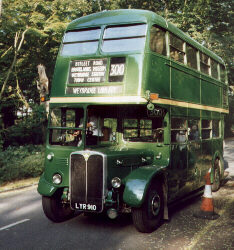
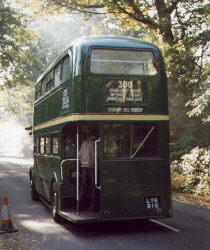
RT3491, operating under the "GREENE LANE" fleet label, on the route 300 special service between Weybridge and Cobham Bus Museun, October 1997.
Photos by Ian Smith.
Click images for larger clearer pictures.
It was almost possible in the sixties to circumnavigate London on Green RTs:
if you were lucky (or unlucky?) on the GreenLine link from Brentford to Romford.
The biggest gap was in the south-west,
where a railway bridge at Staines enforced the use of RLHs.
The Green Rover tickets (five shillings for all day after 9.30) were superb value,
and the long summer holidays were usually enlivened by at least one trip out to see how far we could get.
Starting from Bromley was a handicap, of course, necessitating a long trip on the 402 to Sevenoaks
or the 410 to Westerham for starters (and finishers, of course).
But Horsham, Dorking, Gravesend, and Windsor were all attained.
The RTs were favourites because you could see over the hedges,
run a close second by the RLHs for their novelty value
and the sheer excitement of being on them with their different,
more musical engine note.
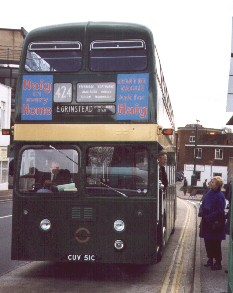 RTs even replaced the RLHs on the 410 in 1964,
when the offending bridge in Oxted was first by-passed
and then made suitable for full-height buses.
RTs even replaced the RLHs on the 410 in 1964,
when the offending bridge in Oxted was first by-passed
and then made suitable for full-height buses.
The green RTs had the normal double-decker work to themselves until October 1965,
when they were joined by the first of the long green Routemasters,
the RMLs.
The big seventy-two seaters took over from RTs on the heaviest Country routes:
the 409 (West Croydon - Forest Row); 410 (Bromley North - Reigate); 411 (West Croydon - Reigate)
in the first takeover.
The long winding 424 (Reigate - East Grinstead) received a different kind of new bus, the XF Fleetline,
a potent of front entrance buses to come. This was followed by the Northfleet group, with RMLs in November 1965.
The first half of 1966 saw the RMLs take over from RTs on the busiest routes around High Wycombe (Feb),
Watford (March), Windsor (May) and Harlow (May).
Portent of things to come: XF1 on the 424 at East Grinstead.
Actually this was a reconstruction, at the April 1998 East Grinstead Running Day,
with organiser Alan Charman at the wheel of preserved XF1.
Photo by Ian Smith, click for a bigger one.

London Country
However, in 1970 the Country Area was hived off from LT to become London Country,
part of the National Bus Company (NBC).
The Green RTs had their fleetnames changed,
and soon received a canary yellow stripe in place of the cream one.
A new logo, a "winged wheel" or "flying polo" according to taste,
appeared briefly on rear offside panels.
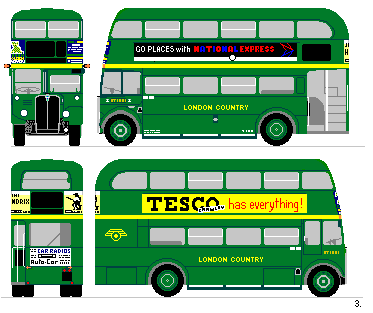
London Country RT 3197 at Crawley Garage, (CY).
in the early 1970's.
Photo, used with permission, by BusSpotter.
Click for larger photo.
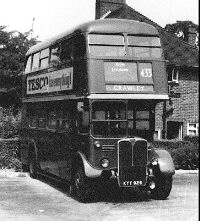
London Country livery on an RT.
Whereas London Transport in 1954 had had an all-modern fleet,
the new London Country management, faced with much the same fleet in 1970,
not surprisingly saw it in a rather different light.
Although the RF fleet had been converted to one person operation,
this was not an option with the RTs or even the "new" RMLs.
The 56 seater dual crew RT became top of the hit-list for replacement.
Merlins and Swifts arrived to displace them,
but as in Central London the sheer reliability of the RTs and RFs
had produced a maintenance, management and financial structure
that was not geared to dealing with fickle new technology that kept breaking down.
So despite the expressions of intent in January 1970
about quick progress towards eliminating the RT,
1971 and early 1972 saw a procession of RTs
heading off to Aldenham for a full overhaul and new 5 year certificates.
RT3752 was the last RT overhauled there, in April 1972
.. and was the only RT to appear in the intermediate London Country green.
But London Country did manage to pursue a one person operation policy,
despite its desperate vehicle problems, and RTs gradually disappeared from its stock.
Thirty four road-worthy examples even went back to London Transport in September 1972!
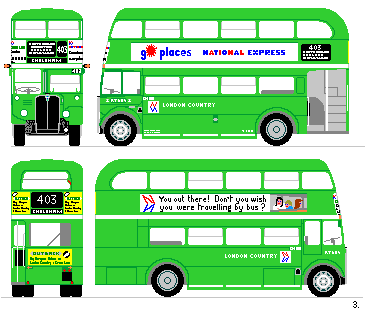 1976 was the crunch year for the class.
At the start of the year they were still operating at various places: Leatherhead, Reigate, Chelsham,
Harlow, Stevenage and Luton, but new Atlanteans pushed them out
so that by the year's end they were only scheduled on the 403 from Chelsham.
Unscheduled appearances occurred elsewhere: Tring used one for GreenLine relief throughout 1976 and into January 1977!
Only 19 RTs still had certificates at the turn of the year, and these would all expire by April.
Nevertheless, appear they still did, even on Hertford's new route 316.
1976 was the crunch year for the class.
At the start of the year they were still operating at various places: Leatherhead, Reigate, Chelsham,
Harlow, Stevenage and Luton, but new Atlanteans pushed them out
so that by the year's end they were only scheduled on the 403 from Chelsham.
Unscheduled appearances occurred elsewhere: Tring used one for GreenLine relief throughout 1976 and into January 1977!
Only 19 RTs still had certificates at the turn of the year, and these would all expire by April.
Nevertheless, appear they still did, even on Hertford's new route 316.
London Country, faced with a crisis on the 403, bit the bullet and recertificated five RTs for service:
RT604, RT981, RT1018 and RT3461. Three of them were repainted, in accordance with
NBC policy, in leaf green:
RT1018, RT3461 and RT604, all working from Chelsham (CM) on the 403.
(RT2230 and RT2367, both trainers, had also been painted this way in 1974).
RT1018 and RT3461 went to join the training fleet in September 1977, leaving
RT981 at Reigate (RG) still in green and yellow on the 406 and 414,
and RT 604 at Chelsham on the 403. RT981 went to be a trainer in February 1978,
and RT604 soldiered on alone until September, when it was retired due to engine failure.
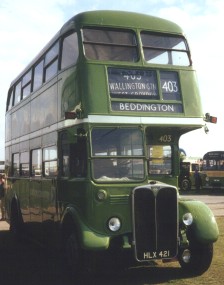
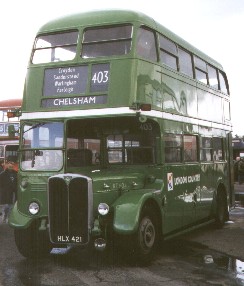
RT604, last of the London Country RTs in service, is happily preserved in NBC green.
It is a regular rally attender, and is seen here at Showbus 97 (left) and Cobham Open Day 1998 (right).
Photos by Ian Smith. Click on photos for larger version.
That was not quite the end of the Country story,
for the trainers persevered for some time, the last,
RT1018, surviving until March 1981 up at Hemel Hempstead. (It then went into preservation).

London & Country
One of London Country's successors has since used an RT in public service. London & Country, the south-western division,
used RT 3775 during the nineties for special duties,
and regularly for the 473 service connecting East Grinstead with the Bluebell Railway.
Acknowledging the vehicle's heritage, it painted it in Lincoln green with cream band and gold fleetnames,
rather than in the contemporary dual green and red.
In 1998 Arriva gave up most of its heritage fleet, and RT3775 moved on to pastures new.
It received an overhaul and repaint (but not green) from Ensignbus.
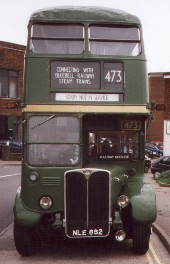
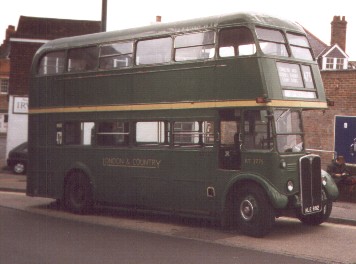
RT 3775 at the East Grinstead Running Day, April 1998.
After five years on the 473 it is looking a bit tired,
and the front dome has taken a battering from overhanging trees. (It has subsequently been sold to Ensignbus and repainted).
Photos by Ian Smith. Click for larger pictures.

 Ian's Bus Stop
Ian's Bus Stop
 RT contents
RT contents
 Part2
Part2
 Part3
Part3
 Part4
Part4

 Often the Country Area had to wait until the Central Area had updated its fleet,
then receiving the hand-downs, but the RTs went to both Country and Central areas,
almost from the beginning.
Perhaps this was because the Country Area had a desperate need
to replace the hand-downs from before the war: STs, TDs and relics from the early thirties.
Often the Country Area had to wait until the Central Area had updated its fleet,
then receiving the hand-downs, but the RTs went to both Country and Central areas,
almost from the beginning.
Perhaps this was because the Country Area had a desperate need
to replace the hand-downs from before the war: STs, TDs and relics from the early thirties.

 As in the Central Area, the Country Area found itself hit hard by the changes in leisure technology.
Car ownership escalated even faster in the properous periphery of London,
and the pre-war experience that Sunday was the busiest day of the week,
with every Country vehicle in service plus many borrowed
from the Central Area for the day changed rapidly
as folk in the inner cities began to experience the joys of weekend motoring.
Evening travel to and from the cinema also suffered from the advent of television.
As in the Central Area, the Country Area found itself hit hard by the changes in leisure technology.
Car ownership escalated even faster in the properous periphery of London,
and the pre-war experience that Sunday was the busiest day of the week,
with every Country vehicle in service plus many borrowed
from the Central Area for the day changed rapidly
as folk in the inner cities began to experience the joys of weekend motoring.
Evening travel to and from the cinema also suffered from the advent of television.


 Thirty six of the new buses (RT3224-3259, by Weymann)
were painted green with a pale green band and labelled for Green Line.
As Green Line "coaches" they carried no adverts,
and had a small raised metal bullseye symbol
mounted on the side panels between the decks.
They were fitted with standard RT seats, but had heaters,
which at that date earned them a new type code: RT8/1.
Thirty six of the new buses (RT3224-3259, by Weymann)
were painted green with a pale green band and labelled for Green Line.
As Green Line "coaches" they carried no adverts,
and had a small raised metal bullseye symbol
mounted on the side panels between the decks.
They were fitted with standard RT seats, but had heaters,
which at that date earned them a new type code: RT8/1.





 1976 was the crunch year for the class.
At the start of the year they were still operating at various places: Leatherhead, Reigate, Chelsham,
Harlow, Stevenage and Luton, but new Atlanteans pushed them out
so that by the year's end they were only scheduled on the 403 from Chelsham.
Unscheduled appearances occurred elsewhere: Tring used one for GreenLine relief throughout 1976 and into January 1977!
Only 19 RTs still had certificates at the turn of the year, and these would all expire by April.
Nevertheless, appear they still did, even on Hertford's new route 316.
1976 was the crunch year for the class.
At the start of the year they were still operating at various places: Leatherhead, Reigate, Chelsham,
Harlow, Stevenage and Luton, but new Atlanteans pushed them out
so that by the year's end they were only scheduled on the 403 from Chelsham.
Unscheduled appearances occurred elsewhere: Tring used one for GreenLine relief throughout 1976 and into January 1977!
Only 19 RTs still had certificates at the turn of the year, and these would all expire by April.
Nevertheless, appear they still did, even on Hertford's new route 316.




 Ian's Bus Stop
Ian's Bus Stop RT contents
RT contents Part2
Part2 Part3
Part3 Part4
Part4